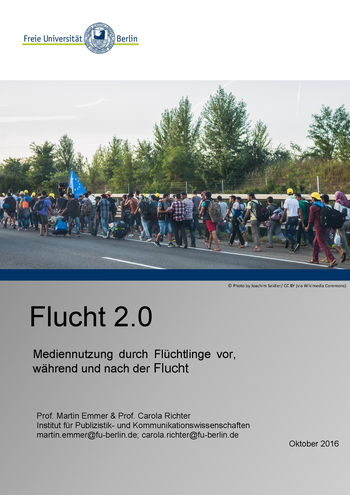Flight 2.0: Digital Media Usage by Refugees
Federal Foreign Office
The research project "Flight 2.0" utilized a representative quantitative survey in refugee housing in Berlin in order to investigate the refugees’ use of mobile devices during the journey from their home countries to Germany. The object of scientific analysis was the refugees’ media usage not only during, but also before and after the flight.
The so-called refugee crisis, which has dominated the media agenda more than any other issue since 2015, was from the very beginning characterized by the digital era: mobile telephones had developed into central tools of those seeking protection, and Wi-Fi hotspots had become as vital as waterholes. The mobile devices enabled access to information for planning the flight, directed the way to the destination country by means of applications such as the GPS, and made it possible for refugees to stay in touch with both those left behind, as well as with the ones who had already fled. Nevertheless, although digital wireless devices evidently played a major role, data on the communication and interaction patterns and their impact on refugee flows (apart from media reports and case studies) were hardly available.
Against this background, the research project "Flight 2.0" examined the refugees’ use of mobile devices on their journey from their home country to Germany using a representative quantitative survey of a total of 404 refugees. The asylum seekers, most of whom had come from Syria, Iraq and Central Asia (Afghanistan, Pakistan, Iran), were interviewed in April and May 2016 by native speakers in Berlin’s emergency refugee shelters. The standardized questionnaire included not only the use of media during, but also before and after the flight.
The results of the study reveal how the refugees use mobile devices as well as what sources of information they draw upon and trust. They also illuminate the pragmatic functions of smartphones in the context of the flight, such as the usage of the GPS or the possibility to obtain information on the Internet about Germany. Going beyond a descriptive record of communication patterns, the study also provides insights into the effects of the usage of information and communication technologies on the refugees’ attitudes and behaviors.
Publications:
Emmer, M., Kunst, M. & Richter, C. (2020). Information seeking and communication during forced migration: An empirical analysis of refugees’ digital media use and its effects on their perceptions of Germany as their target country. Global Media and Communication. Online first. https://doi.org/10.1177/1742766520921905
Richter, C., Kunst, M. & Emmer, M. (2018). Flucht 2.0: Was Geflüchtete wirklich mit ihren Smartphones machen. Social Transformations, 2(2), 1-4. http://www.socialtrans.de/index.php/st/article/view/20
Richter, C., Emmer, M. & Kunst, M. (2018). Von Smartphones, WhatsApp und Misstrauen – Mediennutzung im Kontext von Flucht.Z’Flucht – Zeitschrift für Flüchtlingsforschung, 2(2), 292-312, DOI:10.5771/2509-9485-2018-2-292

